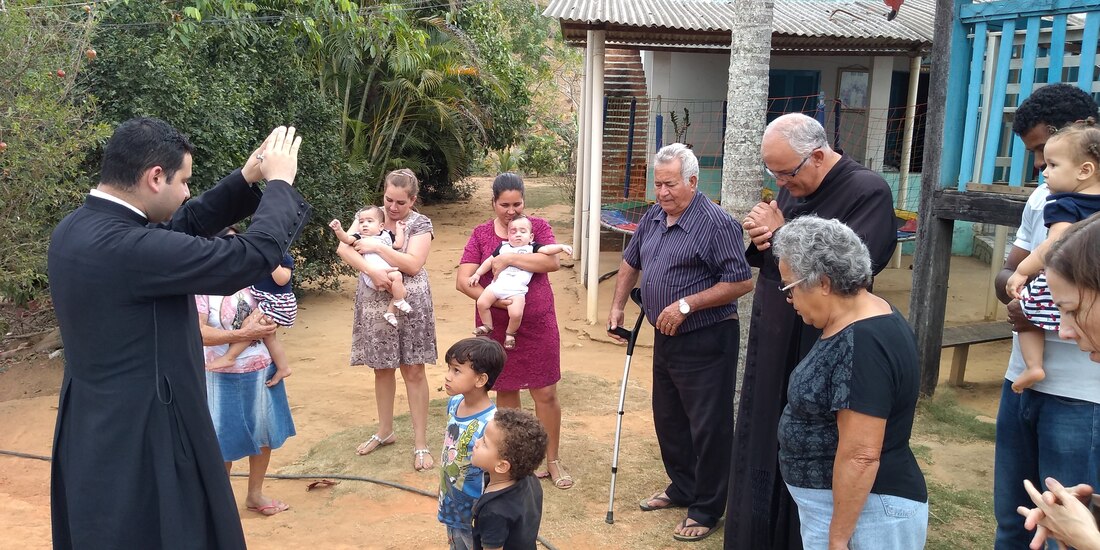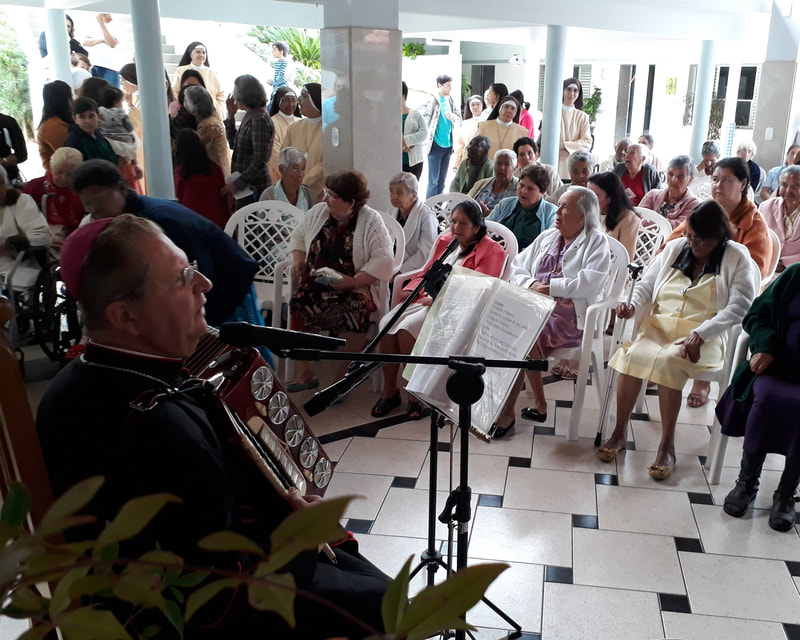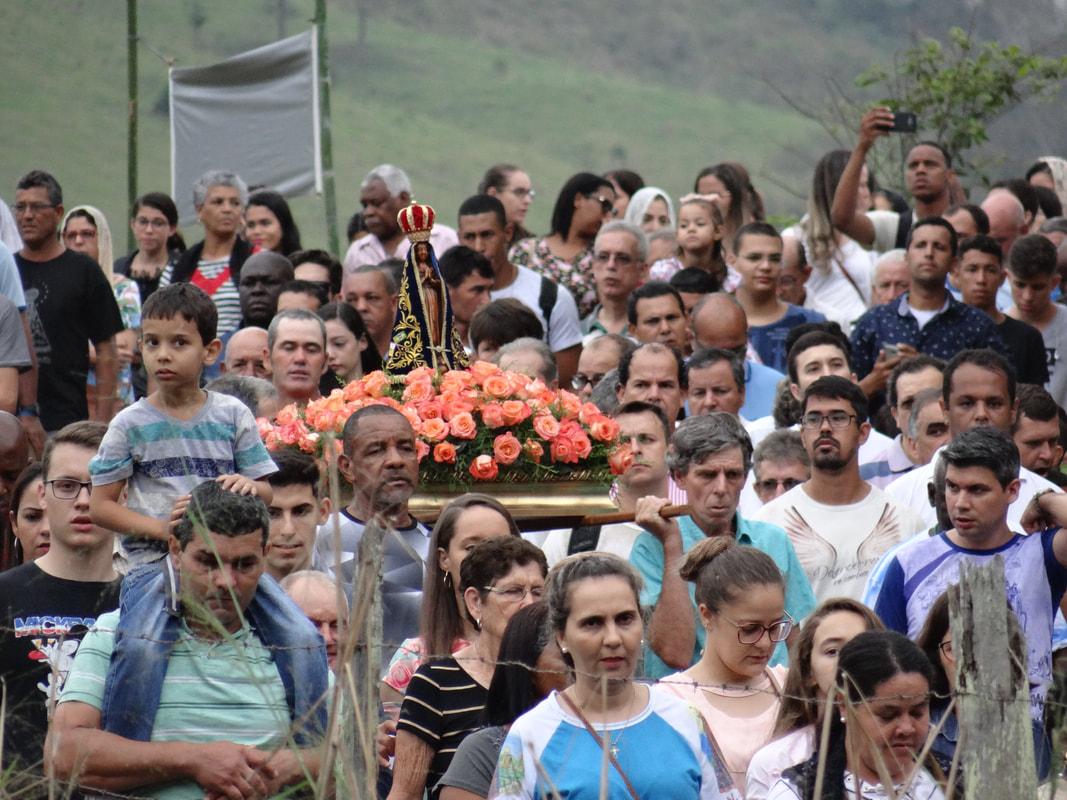|
One of the most startling things for a visiting foreigner, accustomed to the Tridentine Masses of London, New York, Madrid or even smaller places like Harrisburg, Pennsylvania is that in Campos, being a traditional Catholic is not about the liturgy in isolation, but to do with an entire way of life. That is, the tradition that is preserved is not simply the part which is done in church, but is an unselfconscious orientation to a life lived by and for God. The hierarchy of the family and community depends on it. The roles and behavior of men, women and children depend on it. The seasonal cycles of planting and harvest depend on it. Every conversation, meal, and hour spent in work or prayer depends on it. In the village of Varre-Sai, which lies at the farthest point inland in the diocese of Campos, one sees this traditional life even more vividly than in the bigger towns, where “progressive” Catholics and protestants live side by side with the traditional Catholics. In the most rural communities children run enthusiastically to greet adults, kissing the backs of their hands and asking a blessing of priests, teachers, grandmothers and other respected men and women. Boys and girls line up separately and sit separately for catechism, and men and women sit separately in Holy Mass. One stands out of respect when an elder family member or head of household arrives in the home or at the table. One does the same when clergy or religious enter or are introduced. Clothing has meaning for everyone: Clergy in their clerical garb (there are even special cassocks for doing manual labor and for sports and for sleeping); women in women’s garb; men in men’s garb. One puts on nice clothes for Mass. Given that many people do manual labor and even for the less active the climate is very hot the custom of always washing up and putting on clean clothes for meals and for church makes practical sense. The liturgy is not an erudite exercise here. Silence and darkness don’t seem to have the appeal that they have in rainy countries with long winters. The churches are beautiful in a colorful, boisterous, bright way. Everything has been built by hand in dribs and drabs. The high altars are cheerfully ornate, the ceilings painted with scenes for meditation: the mysteries of the rosary, scenes from the Old Testament. Gold paint is used where possible (historic churches are often full of gilded wood and plaster around the altars, balconies and windows). The people are colorful in their dress and enthusiastic in their song and prayer. The dialogue Mass is popular in some parishes. At a weekday evening Mass the women may lead long hymns, and before and after Communion a man might lead prayers of preparation and thanksgiving which the congregation recites together by heart. On Sundays and feasts the parish choirs sing. One priest usually covers both a parish church and the dozen associated rural chapels. When the bishop comes to celebrates for feasts or special events the seminarians come along by busload to sing Gregorian chant and polyphony and provide support for the more elaborate rite. Religious life is not in any way limited to the Mass, but flourishes in the frequent feast days, with their processions, raffles, and opportunities for endless hot pastries and cakes, sold at stands set up around the church yard. It flourishes, too, in the enthusiastic public praying of the rosary, usually led by the parish priest, who alternates the recitation of the Our Father and Hail Mary with the congregation. The Apostolate of Prayer (a centuries-old lay group), the Eucharistic Crusade (a devotional group for children), men’s rosary groups, blessings of homes and fields and factories, calvagadas (processions on horseback), traveling images of Our Lady, and other devotional customs thrive here.
Every parish has a school, a convent, a home for the elderly who have no family to care for them, and other services, depending on the needs of the town. The priests have no rest, blessing and baptizing, visiting, consoling, confessing, and feeding their flocks. They in turn are well cared-for by the parish: sometimes to the chagrin of the recently ordained, who find their cassocks getting too tight from the generous welcomes! The priests are part of the daily life of the community, too, as are the religious sisters resident in nearly every town. There is, of course, no lack of the normal dramas and squabbles of human beings, but there is a recognition that we must care for one another and help one another that is reinforced by the faith of the people, the pastoral leadership of the clergy, the too-familiar poverty, and the natural warmth of heart typical of Brazil. The river Paraiba runs for some 700 miles, starting in the interior of São Paulo, wending its way along the interior of the state of Rio de Janeiro (where it sometimes forms the border with the state of Minas Gerais) and finally cutting down through the diocese of Campos on its way to the sea. In the same river in 1717, three fisherman ‘caught’ a broken clay statue of Our Lady in their fishing nets. After a long day with a poor catch, they were surprised by the find of a statue, and even more surprised when their nets suddenly began to fill with fish. Devotion to Our Lady of Aparecida and her miraculous interventions spread from town to town, and in 1930 Pope Pius XI declared her Queen and Principal Patron of Brazil. Her feast day, October 12, is a national holiday, and the enormous modern sanctuary near the place where the image was found can hold 45,000 people and attracts millions of pilgrims each year. In a twist which Catholics from the northern hemisphere might find unusual, even non-Catholics will make the pilgrimage to the Sanctuary of Our Lady in Aparecida to beg her intercession. So central is she to Brazilian Catholic culture that in the 1970s a protestant man snatched the original image from its high, glass-fronted niche and smashed it into smithereens. The image was tenderly restored in São Paulo and transported back to the sanctuary. The woman who had done the restoration said she’d never seen anything like the greeting that Our Lady of Aparecida got on her return, with thousands of people lining the highway to greet the procession, and truckers pulling over, getting out of their vehicles and kneeling in prayer to honor her. In the diocese of Campos there are many annual processions in her honor, one of the largest being to a little sanctuary a few miles from the town of Bom Jesus. The walk is long, but thousands turn out. Some start in Bom Jesus the night before, and are tended to by residents along the way who offer prayers, snacks, bathrooms, or a place to roll up in ones blanket and get a few hours sleep. Others join in several miles from the sanctuary, in a neighboring village, or closer, if infirmities prevent much walking. When they reach the sanctuary in “Little Aparecida” an outdoor Mass is held, with thousands of people filling the grassy lawn in front of the chapel and overflowing onto the dirt road.
I, too, have fallen in love with Our Lady of Aparecida and gone to the national sanctuary to ask her intercession and, later, to give thanks for her help. The Personal Apostolic Administration of Saint John Mary Vianney organizes an annual pilgrimage, too, bringing the beauty of the traditional Holy Mass to a slightly tumble-down modern chapel built on the edge of the river bank just where the original image was found. That said, the main church of the sanctuary, built on a vast scale to accomodate tens of thousands, is fascinating in its own right. Liturgy and style are very modern, to say the least, but the piety of the thousands of faithful who come to pray is palpable, and the holiness of the place touches ones heart and life. We commend this project, Friends of Campos, to the fierce protection and tender care of Our Lady of Aparecida. |
Friends of Campos, Inc.Friends of Campos, Inc. is a US-based not-for-profit (501c3) which supports the social and educational projects of the Personal Apostolic Administration of Saint John Mary Vianney, most of which are located around the diocese of Campos dos Goytacazes in the state of Rio de Janeiro, Brazil. Archives
April 2023
Categories |
FRIENDS OF CAMPOS, INC. is a 501(c)(3) tax-exempt organization.
© 2023 Friends of Campos, Inc.






 RSS Feed
RSS Feed